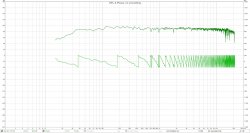Thanks for taking a look at it. There is a lot of treatment in the room. It's a small home studio space where I work on video post-prod and music. Roughly 11x11x8.75'.
I have 12 broadband absorption panels covering the RFZ and back and front walls. All but 2 are 24x48" using 2" thick Roxul Rockboard 80 (compressed mineral wool). And the other 2 are 34"x48" using 3" Roxul Safe n Sound. Those Safe and Sound panels were my first gen units.
In the front of the room (behind my desk) I have 3 edge absorber "bass traps". They are the same 24x48" using 2" mineral wool, but positioned in the corners so they have a larger air gap. Right right and left corners are 2 panels high with a 6" riser, so they go just about to the ceiling. The other front "bass trap" is 17x96" using 3" Safe n Sound. That one is positioned where the front wall and ceiling meet. I have one more corner edge absorber "bass trap" (24x96" 2" Rockboard) where the back wall meets the ceiling.
The "bass traps" were an experiment from something I saw on arqen.com. I have also read or heard Ethan Winer (Real Traps) talk about the same idea. Because the higher traps are so large and such a huge pain in the to mount, I haven't done a test with them in and out of the room. I have tested one of the corner traps in and out of the room and could see some improvement, but it's really small. Based on that test, I am guessing that they are doing a little absorption below 100Hz, perhaps down to 60Hz. But each trap might only be 1-2dB in that range.
I have 2 more 17x48" 3" safe n sound panels just below the monitors tied to the monitor stands. I think it is 22 panels in various arrangements. I made the bass traps because I had a bunch of broadband absorbers in another space that I wasn't using. EQ Below. I am going to be making some more measurements and tweaks in the next few weeks. This EQ was using an average of a couple measurements in the listing position. Something like a few inches in front and behind where I stand/sit (standing desk). I didn't bother to do right and left or the listening position. It get's gnarly real quick.
Equaliser: DCX2496
A,B average
Filter 1: ON BP Fc 2510 Hz Gain -4.5 dB Q 2.00
Filter 2: ON BP Fc 1210 Hz Gain -3.9 dB Q 4.00
Filter 3: ON BP Fc 634 Hz Gain -9.2 dB Q 7.90
Filter 4: ON BP Fc 510 Hz Gain 7.2 dB Q 1.60
Filter 5: ON BP Fc 438 Hz Gain -7.7 dB Q 10.00
Filter 6: ON BP Fc 266 Hz Gain -9.8 dB Q 1.80
Filter 7: ON BP Fc 124 Hz Gain -9.4 dB Q 6.30
Filter 8: ON BP Fc 104 Hz Gain 4.6 dB Q 8.90
Filter 9: ON BP Fc 73.7 Hz Gain 1.2 dB Q 2.20
















